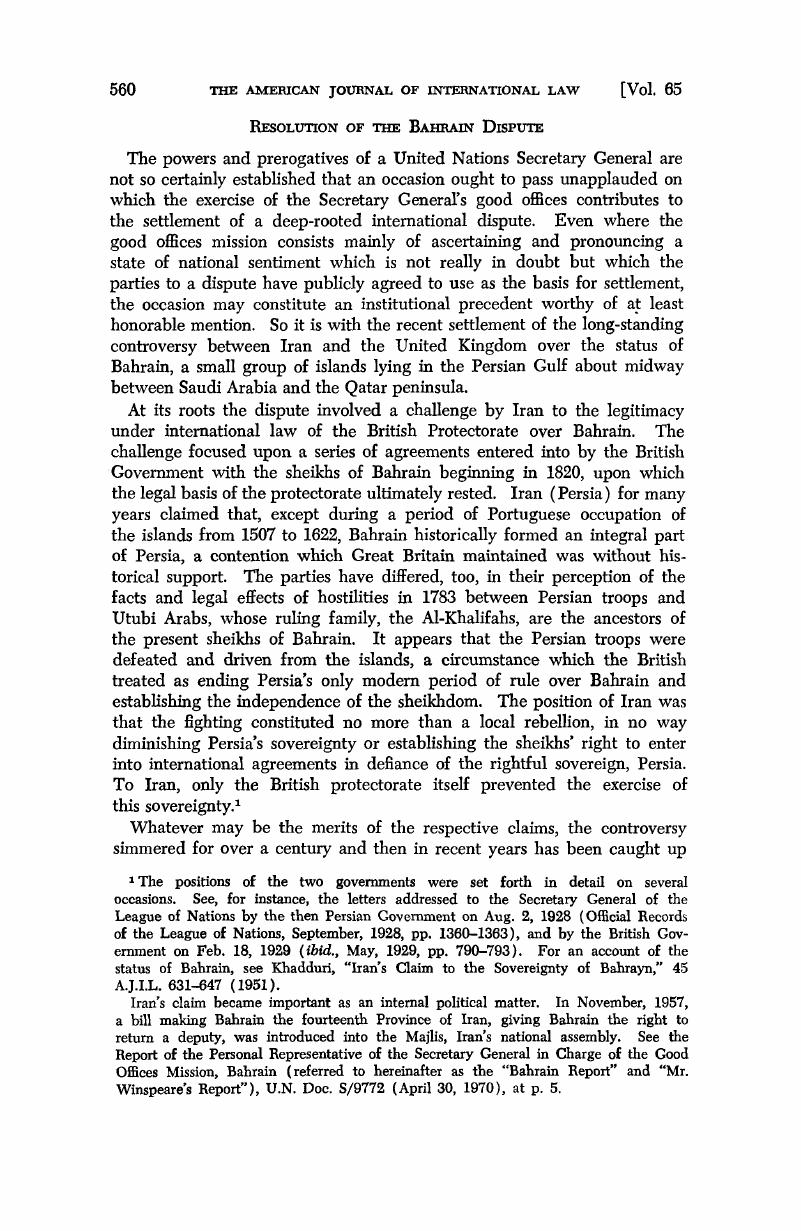Published online by Cambridge University Press: 28 March 2017

1 The positions of the two governments were set forth in detail on several occasions. See, for instance, the letters addressed to the Secretary General of the League of Nations by the then Persian Government on Aug. 2, 1928 (Official Records of the League of Nations, September, 1928, pp. 1360-1363), and by the British Government on Feb. 18, 1929 (ibid., May, 1929, pp. 790-793). For an account of the status of Bahrain, see Khadduri, , “Iran's Claim to the Sovereignty of Bahrayn,” 45 A.J.I.L. 631-647 (1951)Google Scholar. Iran's claim became important as an internal political matter. In November, 1957, a bill making Bahrain the fourteenth Province of Iran, giving Bahrain the right to return a deputy, was introduced into the Majlis, Iran's national assembly. See the Report of the Personal Representative of the Secretary General in Charge of the Good Offices Mission, Bahrain (referred to hereinafter as the “Bahrain Report” and “Mr. Winspeare's Report“), U.N. Doc. S/9772 (April 30, 1970), at p. 5.
2 One of the ways, subtle but revealing, in which this rivalry manifests itself is the effort being made by Arab states, and those whose interests lie with them, to substitute the term “Arabian Gulf’ for the traditional designation, “Persian Gulf.” The Bahrain Report calls it the Persian Gulf and it is so referred to herein. However, one increasingly sees “Arabian Gulf” (as well as “The Gulf,” a term Iran considers to be a pro-Arab substitute for the historic name) used in the literature of, for example, a number of oil companies active in the Middle East. Several recent magazine articles survey the rivalry in depth and in perspective. The Economist, Oct. 31, 1970, at pp. 48 et seq., contains a special section on Iran. Inter- Play for September, 1970, has three comments on the Persian Gulf scenario: Nasmyth, “If the British Leave the Gulf … “ (at p. 4); Cottrell, “A New Persian Hegemony?” (at p. 9); and Dammann, “Saudi Arabia's Dilemma” (at p. 16).
3 See Cottrell, loc. cit. at p. 9.
4 See the Bahrain Report, at p. 6.
5 Ibid, at p. 7.
6 Alvin J. Cottrell, Director of Research at the Center for Strategic and International Studies at Georgetown University, suggests in a recent article, note 2 above, that the Bahrain settlement may have involved British co-operation in resolving in Iran's favor claims by Iran to certain islands, located inside the Gulf at the mouth of the strategic Strait of Hormuz, which are also claimed by British-protected sheikdoms.
7 The text of the interview given by the Shah has been made available by the Iranian Mission to the U.N. The only report of the interview the writer has come across in a Western newspaper is a summary which appeared in the Late London Edition of The Times, Jan. 7, 1969, at p. 4.
8 Text supplied by the Iranian Mission, note 7 above.
9 See Note by the Secretary General Announcing the Good Offices Mission, Bahrain, U.N.Doc. S/9726 (March 28, 1970), at p. 2.
10 The terms of reference as agreed by the parties were: “Having regard to the problem created by the differing views of the parties concerned about the status of Bahrain and the need to find a solution to the problem in order to create an atmosphere of tranquillity, stability and friendliness throughout the area, the Secretary-General of the United Nations is requested by the parties concerned to send a Personal Representative to ascertain the wishes of the people of Bahrain.” See the Bahrain Report, at p. 3.
11 U.N.Doc. S/9726, at p. 2.
12 Ibid, at p. 3.
13 Ibid.
14 The draft resolution appears as U.N.Doc. S/RES/278 (May 11, 1970). The Security Council debate appears as U.N.Doc. S/PV/1536 (May 11, 1970).
15 Bahrain Report, at p. 13.
16 See Introduction to the Report of the Secretary General on the Work of the Organization, U.N.Doc. A/8001/Add. 1 (Sept. 14, 1970), at par. 13.
17 Bahrain Report, at p. 3. The description which follows of the Bahrain mission and its findings is drawn primarily from the Bahrain Report. A brief summary of the mission's work appeared in the New York Times, May 3, 1970.
18 Bahrain Report, at p. 11.
19 The Panel for Inquiry and Conciliation was established on April 29, 1949, under Res. 268 D (III), entitled Study of Methods for the Promotion of International Cooperation in the Political Field, based upon the Report of the Ad Hop Political Committee. The Peace Observation Commission was established on Nov. 3, 1950, under the Uniting for Peace Res. 377 B (V). See Report of the Secretary General on Methods of Fact-Finding, 20 U.N.G.A.O.R. Annexes, Agenda Items Nos. 90 and 94, U.N.Doc. A/5694 (1965), pars. 156 and 158.
20 See Kerley, , “The Powers of Investigation of the United Nations Security Council,” 55 A.J.I.L. 892 (1961)Google Scholar; and Plunkett, “U.N. Fact-Finding as a Means of Settling Disputes,” 9 Va. J. Int. Law 154 (1969).
21 See Report of the Secretary General on Methods of Fact-Finding, note 19 above, at pars. 313-328.
22 See, for example, Servant of Peace: A Selection of the Speeches and Statements of Dag Hammarskjold 335 (1962); and Schwebel, “The Origins and Development of Article 99 of the Charter,” 28 Brit. Yr. Bk. Int. Law 371 (1951).
23 Letter dated April 3, 1970, from the Permanent Representative of the U.S.S.R. to the United Nations addressed to the President of the Security Council, U.N.Doc. S/9737 (April 4, 1970).
24 Letter dated April 6, 1970, from the Secretary General to the President of the Security Council, U.N.Doc. S/9738 (April 6, 1970). The Secretary General had previously set forth his position in a letter to the Security Council which appears as U.N.Doc. S/9055 (March 7, 1969).
25 U.N.Doc. S/PV/1536, at pp. 67-70.
26 Ibid, at pp. 33-36.